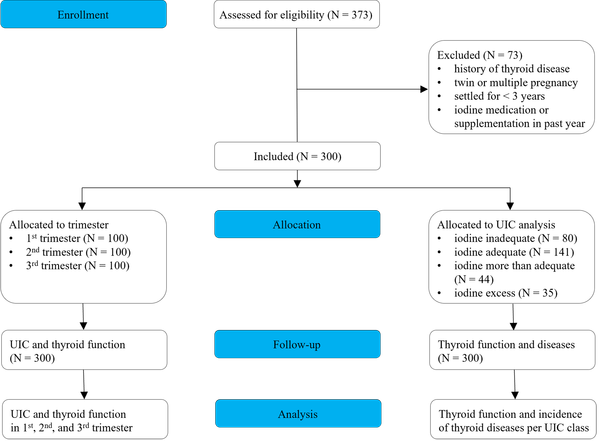-
Home
-
About JCTR
-
Gold Open Access
-
Issues
-
Editorial board
-
Author guidelines
-
Publication fees
-
Online first
-
Special issues
-
News
-
Publication ethics
-
Partners
-
Submit your manuscript
-
Submit your review report
-
Editorial Office
-

This work is licensed under a Creative Commons Attribution-NonCommercial 4.0 International License. ISSN print: 2382-6533 ISSN online: 2424-810X
Volume 8 Issue 6
Iodine nutrition level and thyroid function in pregnant women in the Yongchuan district of Chongqing
Xue Liu, Zhenghua Xiao*, Lan Cheng, Luhong Jian
Liu et al. J Clin Transl Res 2022; 8(6):10
Published online: November 10, 2022
Abstract
Background and aim: To investigate thyroid function-associated parameters and the incidence of thyroid disorders in pregnant women, with the overarching aim to ensure that pregnant women do not develop said disorders due to aberrant iodine levels during the course of pregnancy.
Methods: A total of 300 pregnant women who underwent routine check-ups at the Yongchuan Hospital Affiliated to Chongqing Medical University from January to December 2021 were enrolled. Venous blood and morning urine were collected. Serum thyroid stimulating hormone (TSH), free thyroxine (FT4), and free triiodothyronine (FT3) were determined by chemiluminescence immunoassay. Urinary iodine concentration (UIC) was detected by arsenic cerium catalytic spectrophotometry. Thyroid disorders were extrapolated from the measured parameters.
Results: The overall median UIC was 203 µg/L, which was within normal range. Subgroup analysis revealed that the median UIC in the first trimester was 187.5 µg/L, 211.8 µg/L in the second trimester, and 239.9 µg/L in the third trimester. However, based on WHO criteria, 32%, 30%, and 18% of pregnant women were iodine-deficient during their first, second, and third trimester, respectively. The proportion of women with iodine deficiency in the first and second trimesters were higher compared to the third trimester (P < 0.05). Serum FT3 and FT4 concentrations were higher in subjects in their first and second trimester vs. the third trimester, while serum TSH levels were lower in subjects in their first and second trimester vs. the third trimester (P < 0.05). The TSH concentration in subjects with inadequate iodine intake (UIC < 150 µg/L) was lower compared to subjects with adequate iodine intake (UIC 150 - 249 µg/L), but higher than in subjects with more than adequate intake (UIC 250 - 499 µg/L) and excess iodine intake (UIC ≥ 500 µg/L) (P < 0.05). TSH concentration and UIC were positively correlated (r = 0.1945, P = 0.0007), while no relationship was observed between UIC and FT3 and FT4 serum levels (r1 = -0.0593, P1 = 0.3053; r2 = -0.0149, P2 = 0.7968). There were no significant difference in FT3 and FT4 concentration between different UIC strata (P > 0.05). The incidence of thyroid disease during pregnancy in iodine-deficient women was greater compared to pregnant women with adequate iodine intake (P < 0.05), and higher in subjects in the more than adequate as well as excessive iodine intake cohorts (P < 0.05).
Conclusion: The iodine nutritional intake by pregnant women in Yongchuan District, Chongqing was generally sufficient to meet developmental and metabolic needs. However, about a third of women in their first and second trimester exhibited iodine deficiency. Iodine deficiency was associated with an increased incidence of thyroid diseases.
Relevance for patients: In clinical practice, the UIC of pregnant women should be measured during key stages in the pregnancy to prevent the manifestation of thyroid diseases.

DOI: http://dx.doi.org/10.18053/jctres.08.202206.010
Author affiliation
Department of obstetrics, Yongchuan Hospital of Chongqing Medical University, Chongqing 402160, China
*Corresponding author
Zhenghua Xiao
Department of obstetrics, Yongchuan Hospital of Chongqing Medical University, Chongqing 402160, China
Email: 1921916015@qq.com
Handling editor:
Michal Heger
Department of Pharmaceutics, Utrecht University, the Netherlands
Department of Pharmaceutics, Jiaxing University Medical College, Zhejiang, China

